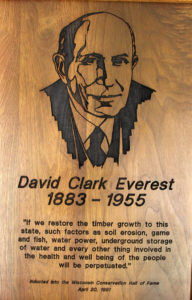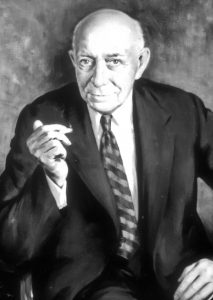1883 – 1955
Inducted 1991
“If we restore the timber growth to this state, such factors as soil erosion, game and fish, water power, underground storage of water and every other thing involved in the health and well being of the people will be perpetuated.” – David Clark Everest
Necessity is the mother of invention. That may explain why a paper company executive became a leader in reforestation efforts in Wisconsin. David Clark Everest, a native of Pine Grove, Mich., accepted an invitation in 1909 to build and manage a paper mill in Wausau. He created a specialty paper production facility now known as Marathon Corporation. Under his 46 years as executive, it grew to be an industry leader.
In 1925, Everest presented a program outlining several proposals he believed were needed to restore Wisconsin’s forests. Fire, neglect and over-harvesting had devastated northern forest resources by the early 1900s. Everest proposed establishing a statewide system of forest fire protection and permitting timber growing without taxation. His efforts led to the Forest Crop Law of 1927. He also supported establishing state-run tree nurseries to reforest state lands. His convincing arguments and strong commitment persuaded the legislative committee studying forestry problems to endorse each of his recommendations.
 At the first-ever commercial forestry conference, which he chaired in 1928 in Milwaukee, Everest outlined his vision for a strong industry based on protecting and restoring Wisconsin forests. When he was asked to chair the silver anniversary forestry conference in 1953, he helped set the stage for forestry management programs for the next two decades.
At the first-ever commercial forestry conference, which he chaired in 1928 in Milwaukee, Everest outlined his vision for a strong industry based on protecting and restoring Wisconsin forests. When he was asked to chair the silver anniversary forestry conference in 1953, he helped set the stage for forestry management programs for the next two decades.
Everest was appointed as a charter member of the Wisconsin Forestry Advisory Council to the Wisconsin Conservation Commission. The council made several notable recommendations during his tenure (1948 to 1955). Among them were state Conservation Department purchase of remaining commission holdings in the Flambeau River State Forest, establishment of a cooperative program of forestry research at the University of Wisconsin-Madison and expansion of the Conservation Department’s role in farm forestry and watershed management.
Everest helped found the Institute of Paper Chemistry in Appleton and served as a trustee from 1929 until his death in 1955. He also served as president of the American Paper and Pulp Association and the American Forestry Association. In recognition of his conservation accomplishments, the American Forestry Association presented Everest with a distinguished service award in 1949.
Resources
David Clark Everest Legislative Citation
David Clark Everest – Paper Industry International Hall of Fame video
New Mural Saluetes David Clark Everst, article by Michelle Rothmeyer for the Everest Herald, 2015
A Man and a Company, publication from the Marathon County Historical Society
Woodlot and Ballot Box – Marathon County in the Twentieth Century, (excerpt) by Howard R. Klueter and James J. Lorence, 1977
In memoriam – David Clark Everest by Charles Inglis for Wisconsin Academy Review, 1956
David Clark Everest – Businessman and Historical Society President from the Wisconsin Historical Society
No More Branches But Each Has Grown And How! holiday card from Wisconsin Historical Society
Wish You a Merry Christmas holiday card from Wisconsin Historical Society
Merry Christmas holiday card from Wisconsin Historical Society
Eisenhower Christmas holiday card from Wisconsin Historical Society
Photos
These images may be used under the Creative Commons Attribution-NonCommercial-NoDerivatives 4.0 International License.


